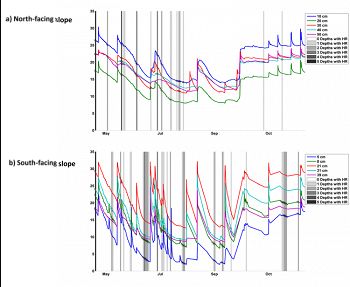Hydropedo Toolbox
Hydropedograph Toolbox
A MATLAB-based toolbox for analysis of time series data for soil moisture profiles
Model Category: Numerical
-
IML, Shale Hills, INVESTIGATOR
The Hydropedograph Toolbox has been developed to provide a set of standardized tools for analyzing soil moisture time series in an efficient and consistent manner. This toolbox contains various modules that permit the exploration and visualization of key soil hydrological parameters and processes using multi-depth real-time soil moisture monitoring datasets. This includes statistical summary, soil water release curve, preferential flow occurrence, hydraulic redistribution, and the relationship between soil moisture and soil temperature.
A comparison of hydraulic redistribution occurrence between a north- and a south-facing midslope sites in the Shale Hills CZO in 2010. Shade of vertical lines indicates the number of soil horizons exhibiting diel signals (0 to 5 horizons as indicated by the gray ramp from white to black). It is apparent that the south-facing site had more prevalent hydraulic redistribution, likely due to higher evaporative demand during the growing season.
The case study illustrates the topographic impacts on soil moisture dynamics along a hillslope transect, and quantifies the frequency of the occurrence of preferential flow, diel fluxes of water, and seasonal storage dynamics. It is expected that such a toolbox, with continued enhancement in the future and wide applications across diverse landscapes, can facilitate the advancement of comparative hydrology and hydropedology.
A comparison of hydraulic redistribution occurrence between a north- and a south-facing midslope sites in the Shale Hills CZO in 2010. Shade of vertical lines indicates the number of soil horizons exhibiting diel signals (0 to 5 horizons as indicated by the gray ramp from white to black). It is apparent that the south-facing site had more prevalent hydraulic redistribution, likely due to higher evaporative demand during the growing season.
Explore Further


